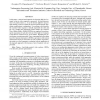3593 search results - page 123 / 719 » A Generative Model Based Approach to Motion Segmentation |
CVPR
2000
IEEE
14 years 11 days ago
2000
IEEE
Many communicative behaviors in the animal kingdom consist of performing and recognizing specialized patterns of oscillatory motion. Here we present an approach to the representat...
ICIP
2000
IEEE
14 years 11 days ago
2000
IEEE
Gradual transitions represent a challenging problem for temporal segmentation of video. Here we present two new features for detecting these. Recently, Ngo et al. set out a method...
IROS
2008
IEEE
14 years 2 months ago
2008
IEEE
— This paper presents a method to autonomously extract object features that describe their dynamics from active sensing experiences. The model is composed of a dynamics learning ...
ICIP
2008
IEEE
14 years 9 months ago
2008
IEEE
In this paper, a motion-based approach for detecting high-level semantic events in video sequences is presented. Its main characteristic is its generic nature, i.e. it can be dire...
ACL
2009
13 years 5 months ago
2009
Most NLP applications work under the assumption that a user input is error-free; thus, word segmentation (WS) for written languages that use word boundary markers (WBMs), such as ...

